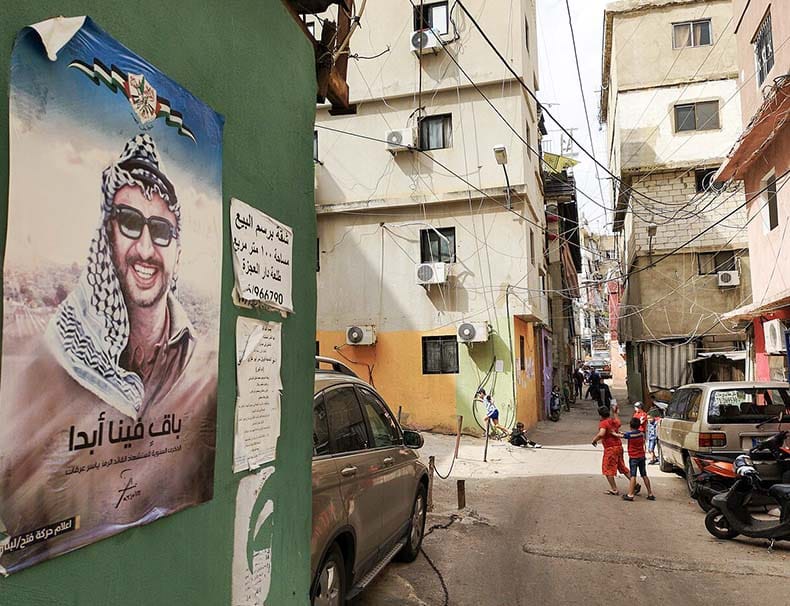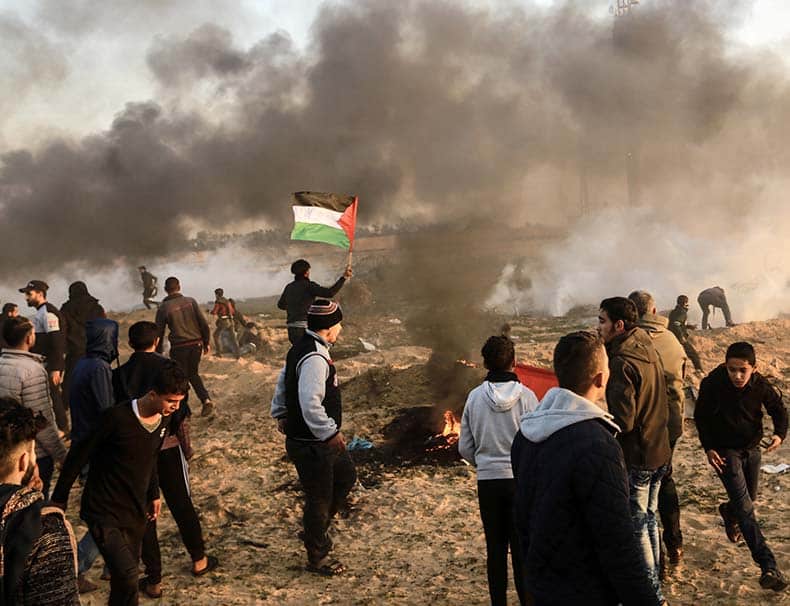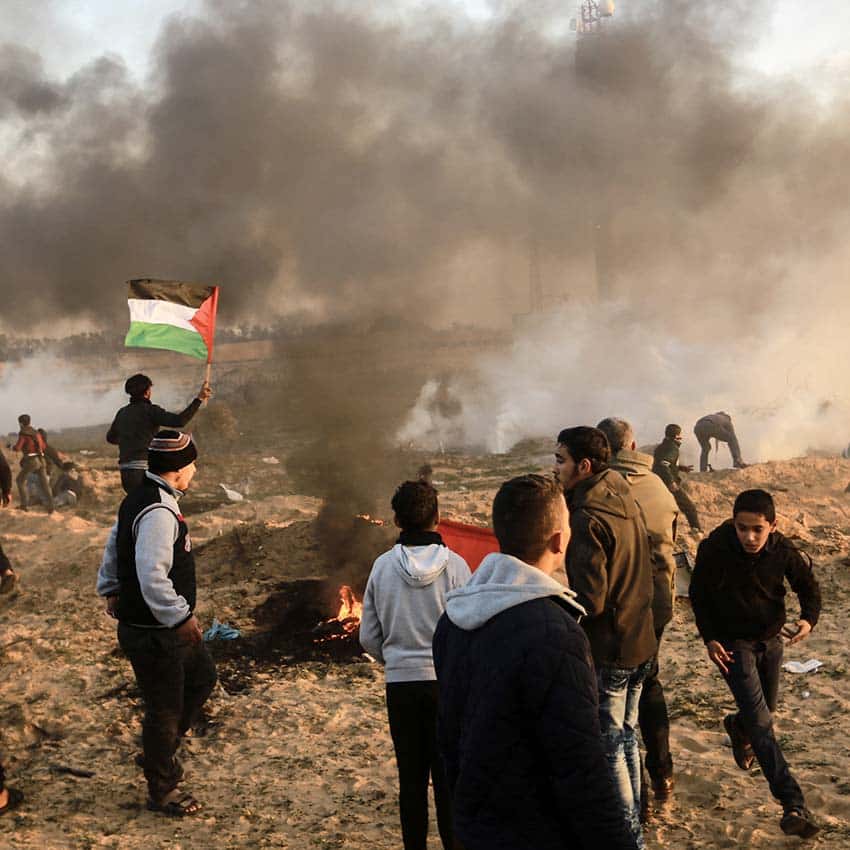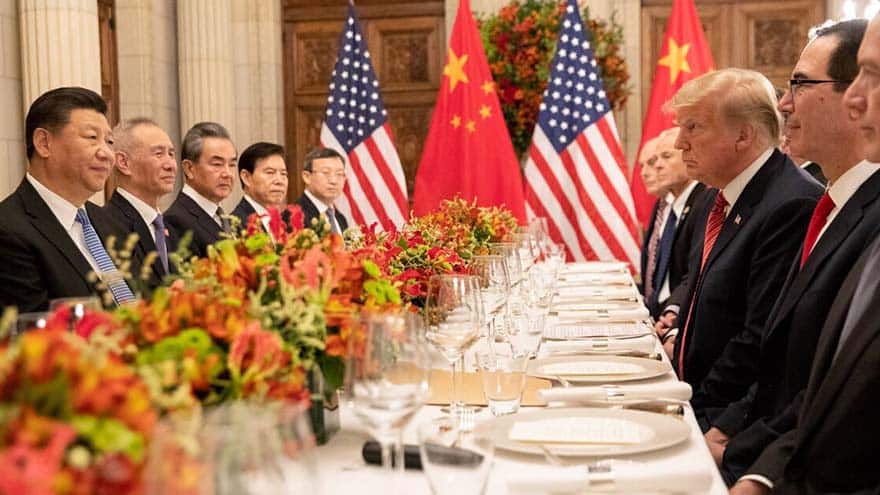Every year on May 14, Palestinians everywhere mark Nakba Day, and this year was no different, even amid the brutal war imposed on us. Among other things, they held student events at universities in Israel, waving Palestinian flags and declaring that nothing will prevent them from remembering what they define as the terrible crime they endured as a nation, and nothing will make them forget their obligation to cry out and express solidarity with what they view as the genocide of the Palestinian collective in the Gaza Strip, as part of efforts to prevent them from realizing their national aspirations.
In recent years, mass rallies have taken place among the ruins of many Arab villages, one of them being the settlement of Khubayza in the Iron Valley (Wadi Ara), where Palestinian flags were waved and calls were made to return displaced Arabs (who will be discussed further below) to their homes. As stated by MK Ahmad Tibi, who participated in these events: “In our protest, in places where Arabs lived and owned the land before the establishment of the State of Israel, we emphasize our right to the homeland. Not the right to the land, but the right on the land, on the place. Because we are the landowners, and not just citizens who have a right to it—this is our historical homeland—we are the original homeowners!”
The displaced were residents of Arab villages who, as a result of battles during the War of Independence, were uprooted from these places and resettled in other Arab villages within the Green Line. For example, the displaced from Tzippori were settled in Nazareth, those from Ness Ziona moved to Lod and Ramla, and refugees from Lajjun (Megiddo), Ein Ghazal (Ein Ayala), Ijzim, and Jaba in the Carmel fled to the Iron Valley. In many cases, they and their families—now numbering about half a million people—gaze from their new homes at the lands of their forefathers, which they lost in the war. It is important to note that many of the displaced played an active role in the War of Independence, and their expulsion from their homes was justified and legitimate, as they were part of the Arab enemy that fought against the Zionist settlement during the war and beforehand.
“A Land Clothed in Sackcloth and Ashes”
In recent years, the displaced and their descendants have renewed their demand to return to their abandoned villages or, at the very least, to reclaim the agricultural lands they once owned. They have sought to establish neighborhoods for their continuing generations on lands where moshavim and kibbutzim were established, and to have their rights equated with those of the new residents. Israeli governments rejected their demands, viewing them as attempts to alter the Jewish character of the state and the demographic reality in the lowlands, the Carmel, the Galilee, and the Sharon.
Al-Hirak al-Fahmawi, an organization that advocates for changing the Jewish nature of the state, engages in provocative actions against symbols of the government and, along with residents of Umm al-Fahm, regularly visits the ruins of the village of Lajjun near Kibbutz Megiddo. Mounted on horses, they liken themselves to the early Islamic warriors who, through “Ribat al-Khayl”—cavalry forces—were spiritually bound to the lands they conquered through “Fath” (liberation) from the infidels. Then, as now, they see themselves as the liberators, and the other side as the “occupier.”
The demand for return is far broader. On March 30, 2018, a series of mass protests began on the Gaza Strip border, which in the years leading up to the events of October 7 turned into particularly violent riots. The Palestinians called them the “Great March of Return,” explicitly aimed at enabling the return of Palestinian refugees to within the Green Line.
Although the rioters’ demands were precise and Hamas’s plans were widely known, relevant authorities looked the other way. The horrific massacre occurred at full force, leading to war, a reshaping of the Middle East, the collapse of the Shiite axis, and the rise of a Sunni axis led by Saudi Arabia, alongside the strengthening of the Muslim Brotherhood axis led by Qatar and Turkey.
Palestinians estimate the number of refugees at six million people. The absurdity is that, unlike other cases of refugees around the world, Palestinian refugee status is inherited by a UN resolution. At the start of the First Aliyah in 1882, the total population of the land was just 200,000 residents. As Zionist immigration increased and with the development efforts brought by the British Mandate authorities, more than half a million Arabs migrated to the land from surrounding countries. These joined recent migrants from Egypt, who had come as forced laborers with Ibrahim Pasha’s armies in 1831. North Africans, Turkmens, Circassians, and Bosnians also arrived, encouraged by the Ottoman Empire, along with nomads from Kurdistan, eastern Transjordan, and Syria, who wandered in search of pasture and other opportunities.
The origins of these migrant workers are reflected in their surnames, including Yamani, Masri, Halabi, Ajami, Hourani, Kurd, Turkman, and Turk. Yet in their struggle to establish an Arab state, these Arabic-speaking migrants claimed that the first Zionist settlers had usurped the land of the Arab-Palestinian people, who had allegedly established a life here with a distinct Arab-Palestinian identity and culture.
Contrary to these claims, and based on descriptions by pilgrims and travelers—including American author Mark Twain, who visited the land in 1867, just a few years before the arrival of the first Zionists—a completely different picture emerges. Twain documented what he saw with his own eyes and wrote: “Of all the lands there are for dismal scenery, I think Palestine must be the prince… It is a desolate country whose soil is rich enough, but is given over wholly to weeds… a silent, mournful expanse… A desolation is here that not even imagination can grace with the pomp of life and action. Palestine sits in sackcloth and ashes… desolate and unlovely.”

Preserving the Struggle Against the Return of the Jews
The remarks of MK Ahmad Tibi mentioned earlier are a direct continuation of the claims made by certain Arabs, reflecting the clear and traditional stance of asserting exclusivity when it comes to indigenous rights in Palestine. They will never recognize Zionism as a legitimate national movement, as they view it as a colonial and imperialist enterprise. Tibi’s demand, which reflects the views of hundreds of thousands of Israeli Arabs to return the original inhabitants to their homes, proves that even the so-called “moderate” Arabs have not granted legitimacy to the 1948 borders, do not accept the outcome of the War of Independence, and regard the Jew as an intruder who has seized the lands of their forefathers.
I believe that the struggle for the liberation of Palestine is not merely a national one. Those who are referred to as Palestinians are the vanguard of all those seeking to prevent the Jews from returning to their land and establishing their state in it, because their return fulfills the vision of the prophets regarding the ingathering of exiles and the establishment of the Third Kingdom of Israel or the sovereignty of the people of Israel in their historical homeland. This return refutes the claims of Christianity and Islam to superiority over Judaism, as if they were more advanced religions, and is a thorn in their side. It is no coincidence that the Palestinian national movement includes both Christians and Muslims under its wing, united in their hatred of Israel.
The Islamists see the return of the Jews to their land as an opportunity to destroy them. In doing so, they distort the meaning of a verse in the Quran from the Surah of the Children of Israel, which addresses the return of the people of Israel to their land. This Surah is now called “The Night Journey” (Surah 17), partly to deny the identification of modern Jews with the Children of Israel mentioned in the Quran. Verse 104 of the Surah reads: “We said to the Children of Israel: Dwell in the land, and when the final promise comes, We will bring you forth in a mingled crowd.” This verse is an Islamic echo of God’s call through Moses to the people of Israel to enter the land of Canaan and inherit it. It is akin to the Jewish prayer for the ingathering of exiles: “Sound the great shofar for our freedom, raise a banner to gather our exiles, and gather us together (lafif, in Arabic) from the four corners of the earth to our land…”
To fulfill the Quranic verse that appears at the end of the passage concerning the twice-exiled people of Israel from their land, the possibility of a third redemption is detailed:
“(4) And We conveyed to the Children of Israel in the Scripture that: ‘You will surely cause corruption on the earth twice, and you will surely reach [a degree of] great haughtiness.’
(5) So when the [time of] promise came for the first of them, We sent against you servants of Ours—those of great military might (the Babylonians – Y.S.), and they entered the innermost parts of your homes. And it was a promise fulfilled.
(6) Then we gave you a return victory over them. And we reinforced you with wealth and sons and made you more numerous in the workforce.
(7) [And said], ‘If you do good, you do good for yourselves; and if you do evil, [you do it] to yourselves.’”
In effect, the preservation of Palestinian refugee status is intended to perpetuate the struggle against the return of the Jews to their land indefinitely. It is no coincidence that there is widespread opposition in the Arab-Islamic world to the deportation of Gaza residents beyond the territory of the Strip. The Palestinians—especially the Gazans, who led the first Intifada in Israel and the “Iron Swords” war—are at the spearhead of the Islamic struggle to prevent the lands of Dar al-Islam (the House of Islam) from falling into the hands of foreigners—Jews and Christians—the new Crusaders. The irony is that those who have cried out for years that they are refugees, even though they are the third or fourth generation of someone who left Palestine/Land of Israel, have now truly become refugees.

Only Total Collapse
The demand for the right of return and participation in the “Marches of Return,” alongside the incitement campaign led by UNRWA and systems perpetuating deep-seated hatred—fueled both by the PLO and the Fatah movement under Arafat and Abbas, as well as by their rivals in Hamas—did not bring the Palestinians closer to returning to the promised land, but rather to the first practical solidification of their new refugee status in 2023. An additional two million people, the vast majority of whom have never experienced true refugeehood and were born as the first, second, or third generation of Gazans, were added to the count.
The aspiration for Palestine “from the river to the sea” has turned even those born in Gaza over the past 77 years into actual refugees. Alongside them, tens of thousands of residents from refugee camps in northern Samaria—Jenin and Tulkarm—who had never tasted the experience of refugeehood, acquired this new status by right, not by grace. They attempted to perpetrate terrorism against Israel and were expelled from the camps. Mahmoud Abbas, who led diplomatic terror against Israel, became the head of a fractured and hollow authority that has nothing to do with a future state.
One thing is obvious: the Green Line is not the final border in the eyes of the Arabs/Muslims. Therefore, instead of speaking of another state in the Land of Israel, settlement in the land must be deepened, the Zionist narrative strengthened, and education must be rooted in the outlook of Shimon the Hasmonean: “We have not taken a foreign land, nor seized the property of others, but rather the inheritance of our ancestors.”
As long as the builders of the land do not actively adopt the words of the Mandate Charter for the Land—“The Mandatory Government will encourage close settlement by Jews on the land, including State lands and waste lands not required for public purposes”—the Zionist vision will never be secure.
Alongside this, steps must be taken to bring the Palestinian issue to a conclusion. To that end, Israel must not end the war without having brought about the complete collapse of all empty or ruined structures that could endanger our soldiers, alongside the destruction of the underground threat by detonating and eliminating subterranean assets. When all buildings in Gaza are dismantled to the ground and all sewage, water, and electricity infrastructures are destroyed, we will know that Hamas terrorists are no longer a threat, though it will take considerable time. As long as fighting continues, the exit of Arab residents from gathering zones and humanitarian shelters into the destroyed settlement areas must be prohibited.
Regarding the administrative status of the Gaza Strip, it will have to be managed under municipal control only. Once the Hamas movement, which enjoyed full civilian support, initiated the war, it brought the sword of calamity upon all its residents. All those “non-combatants” who chose Hamas in democratic elections will have to find their way out of the territories of the Land of Israel. Those who do not believe such a solution is possible should study the forced migration experienced by Turks living in Greek territory, and similarly by Greeks from modern-day Turkey, as well as the migration of Hindus from Pakistan to India and vice versa. And above all, the migration of Jews from Arab countries to the Land of Israel, and the departure of Arabs from the territory of the Jewish state during the War of Independence. The Nakba of 2023 is a done deal. Now, the State of Israel must act to implement the role of a migration authority for the relocation of Gaza residents to suitable countries.
One thing is sure: when Arafat, Mohammed Deif, and Yahya Sinwar look down from above at the works of their hands, they see before them a gathering of people who have become refugees, instead of a nation that has attained an independent state.









